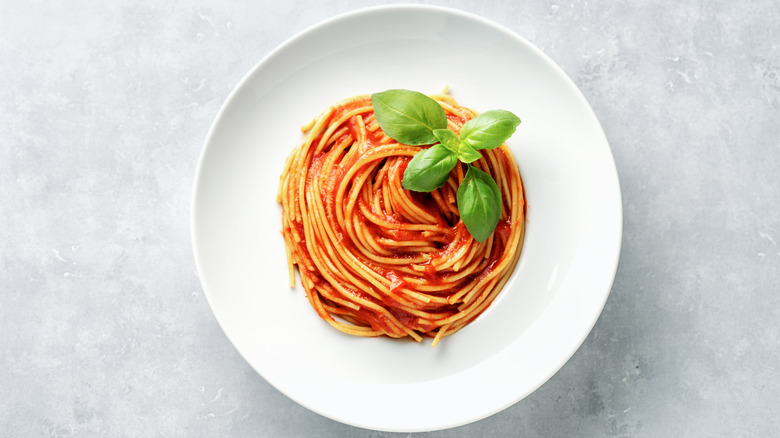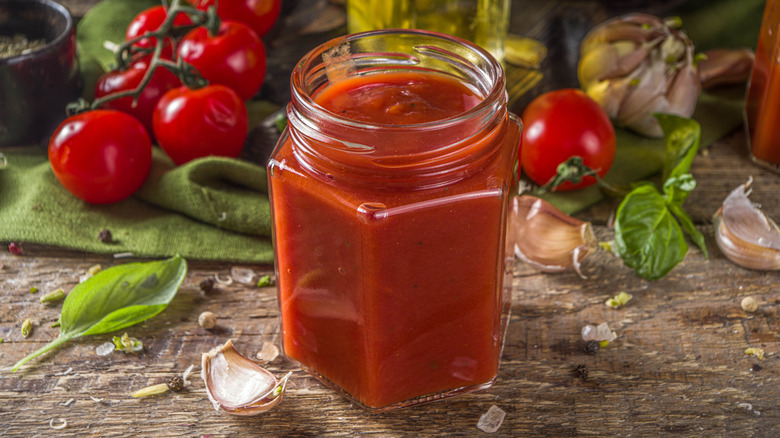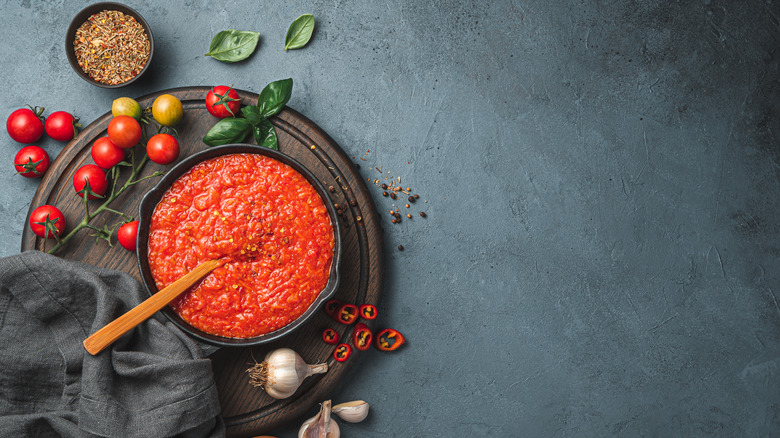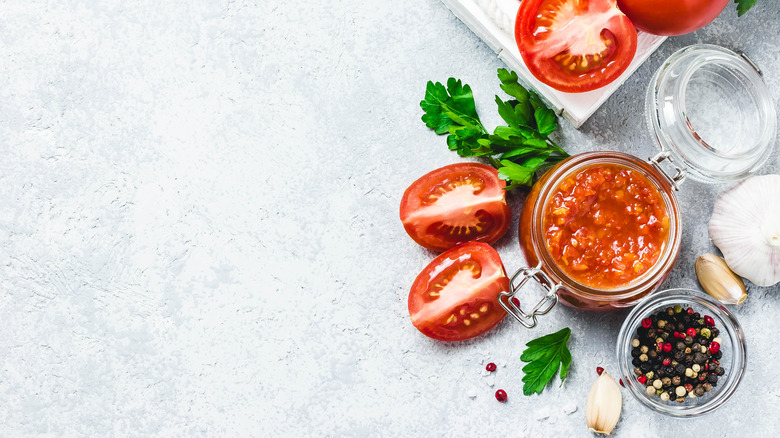The Difference Between Tomato Sauce And Marinara Sauce
Walk into almost any Italian restaurant and you'll find a plethora of pasta dishes on the menu, and many of them most likely contain a tomato-based sauce. It does, after all, do an excellent job binding the carb together with herbs, spices, and tender proteins like sliced sausage and meatballs. But when dining on such delicate noodles like bucatini, campanelle, and perciatelli (all of which pair exceptionally with tomato-based pasta sauces, according to the Food Network), one may find themselves wondering, "Is this marinara sauce I'm eating, or tomato?" And more importantly, what's the difference between these two popular sauces?
Marinara sauce and tomato sauce are often used interchangeably and for clear reasons; the two look and taste quite similar to each other. But such nuances within their textures, cooking processes, and flavor profiles are the very things that separate these two sauces into different categories ... and make each better suited to different recipes. But before we dive into their differences, let's talk about what tomato sauce and marinara sauce actually are.
What is marinara sauce?
According to pasta sauce company Paesana, marinara sauce is made by combining olive oil, garlic, and basil with whole peeled tomatoes (preferably the San Marzano kind). Its tasting profile is bright and its texture is thin, which makes it a perfect ingredient when you're concerned about overpowering the rest of your meal's flavors. Pizza is a great example of this, as marinara sauce is often used to hold toppings in place while imparting a light tomato flavor. The same goes for serving alongside calamari or fried mozzarella sticks; the marinara sauce will help to accentuate the dish's flavor without stealing its thunder. If tomato sauce was used in place, you would likely overpower these foods.
Marinara is fairly simple to make, with Love & Lemons stating that 20 minutes is all you need to transform a can of crushed tomatoes into the tangy Italian sauce. You can also find it in plenty of comforting pasta recipes like spinach-stuffed shells, Pasta alla Norma, and cheese manicotti.
What is tomato sauce?
Serious Eats explains that tomato sauce is almost like a stew, and takes several hours to make. Most recipes start with a soffrito comprised of minced carrots, onions, and celery, per Cooks Info, with ingredients like olive oil, garlic, butter, and herbs added (in addition to tomato, of course) to give the sauce depth and flavor. For seasonings, all the Italian standards are usually present: salt, black pepper, oregano, and basil. After being allowed to cook down, the finished sauce will have an almost jammy, thickened consistency, and taste sweet, rich, and caramelized.
There's also a French version of this sauce, called sauce tomate, which the Escoffier School of Culinary Arts says is made with roux. One of the five French mother sauces, it's traditionally comprised of tomatoes, herbs, stock, and animal-based fat, such as pork. (While many recipes omit the animal fat to make the sauce suitable for vegetarians, you may want to ask if you spot it on a menu.)
Italian tomato sauce variations include vodka sauce, ragu, and arrabbiata sauce, which take the basic red sauce and add some additional ingredients to transform it into something completely different.
Tomato sauce is of course wonderful in Italian pasta dishes like spaghetti and lasagna, but is also used to make dishes like shakshouka.
Do you prefer fresh flavors or rich complexity?
So when it comes down to it, how do the two actually differ? In short, tomato sauce has much more depth and complexity than marinara sauce, as well as a longer list of ingredients. It's best to think of marinara sauce as a basic form of tomato sauce, especially since its flavor notes, cooking time, and ingredient list are all short and sweet, per Paesana. Marinara sauce is also quite thin compared to tomato sauce's thick texture.
Taste-wise, marinara sauce has a more fresh flavor, as it only needs about 20 minutes to cook, per Love & Lemons. The flavors don't have as much time to develop as they would for tomato sauce, and any added herbs like basil and oregano will be more prominent. Tomato sauce, on the other hand, is typically sweeter, since it can take several hours to reduce. (The Spruce Eats suggests a minimum of two to three hours, but possibly more if the tomatoes have a high water content; Serious Eats goes as far as to say it should cook down for five to six hours.) There is also a heightened richness and deep savory profile in tomato sauce that you're unlikely to get from marinara.



